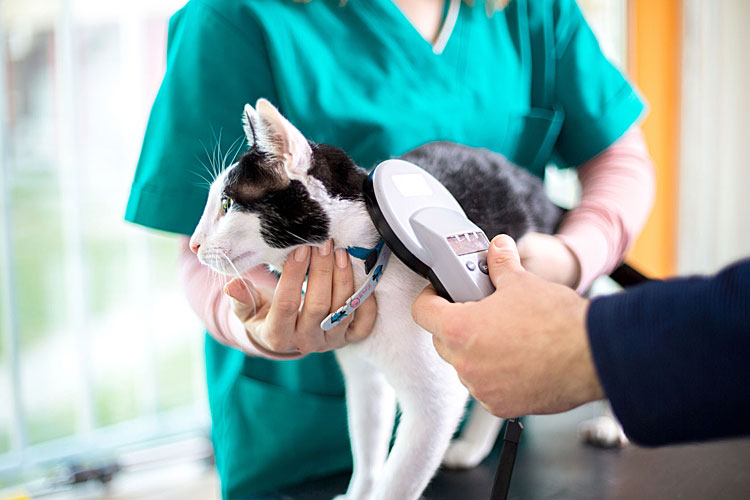By Tiffany L. Mitchener, DVM Capitola Veterinary Hospital

What is Microchipping?
A microchip is a glass cylinder, roughly the size of a grain of rice, containing a very small electronic chip. It is implanted under the skin of the dog or cat. The microchip lasts the lifetime of the pet. It has no battery requirement, no moving parts, nothing to wear out or replace.
The microchip is implanted under the skin between the shoulder blades of the pet with a hypodermic needle. It is very similar to a vaccination injection. The procedure should be performed by a professional to make sure that the microchip is placed at the appropriate depth and location on the pet’s anatomy. Your local veterinarian can microchip your pet.
How does the microchip work?
Does microchipping your pet increase your chance of a happy reunion?
In a 2009 study reported in the Journal of the American Veterinary Medical Association, 7700 stray animals from multiple animal shelters were followed. Dogs with no microchips were reunited with their owners 21.9% of the time. Dogs with microchips had a 52.2% reunion rate. That means over half of the dogs with microchips were found by their owners!
The research was even more dramatic on the feline side. Microchipped cats were reunited 38.5% of the time with their families. But only 1.8% of cats without microchips were found by their owners. That means fewer than 2 out of 100 non-microchipped cats are being found by their owners, an incredibly low number, compared to almost 40 out of 100 microchipped cats enjoying happy reunions. Having your pet microchipped, and keeping your contact information current, significantly increases the likelihood of finding him when he is lost.
Are there any risks to microchipping my pet?
The risks of implantation of the microchip are similar to the risks of any injection; in rare cases, there can be pain or inflammation at the injection site initially. But what about long term consequences? Since 1996, the British Small Animal Veterinary Association has been maintaining a list of adverse reactions when dogs and cats are microchipped. Of the four million animals microchipped in Britain, 391 have had an adverse reaction. That is fewer than 1 out of every 10,000 animals microchipped. Interestingly, the most common adverse reaction is migration of the microchip away from the original implantation site.
Do I have to microchip my pet?
In 2013, an ordinance was passed in Santa Cruz County that all dogs and cats over the age of four months must be implanted with an identifying microchip. Santa Cruz County is one of the few jurisdictions in the state of California with this requirement. Not only is microchipping of great benefit to reuniting lost pets with their owners, it is also the law!
How do I maintain my pet’s microchip?
Microchips last for the lifetime of the pet. There are no batteries or other power sources that need to be maintained. However, it is important to follow a few simple steps after microchipping your pet. First, register the microchip number originally with the appropriate database; registration can be done online or with a simple phone call.
Second, have your pet scanned by your veterinarian every year at his wellness exam to ensure that it can still be read accurately. Finally, and most importantly, keep your information current with the database. It is that simple! Microchipping is a permanent way to maintain the identity of your pet, and in the event of a crisis, increase your chances of a happy ending.